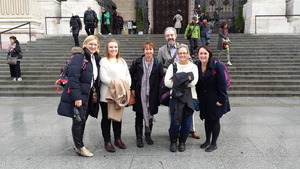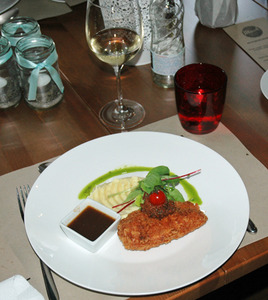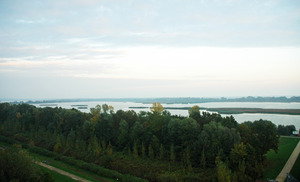Budapest & Eger
 Salt – laden thermal springs pop up all over Hungary, sometimes even bringing salt to the surface. The spa culture can be found right at the heart of beautiful Budapest where the enormous and historic Széchenyi baths provide invigorating and therapeutic recreation for locals and tourists alike. But just as the underground waters spread far beyond the capital, so do the opportunities for visitors to enjoy the unique Hungarian landscape, culture and hospitality; as a recent four-day tour on behalf of Silver Travel Advisor has proved. Brilliantly organised by Anita Sipos of Hungarian Tourism Ltd, this took us from Budapest via charming Eger to the distinguished second city, Debrecen, and beyond to the Hungarian steppe – the puszta.
Salt – laden thermal springs pop up all over Hungary, sometimes even bringing salt to the surface. The spa culture can be found right at the heart of beautiful Budapest where the enormous and historic Széchenyi baths provide invigorating and therapeutic recreation for locals and tourists alike. But just as the underground waters spread far beyond the capital, so do the opportunities for visitors to enjoy the unique Hungarian landscape, culture and hospitality; as a recent four-day tour on behalf of Silver Travel Advisor has proved. Brilliantly organised by Anita Sipos of Hungarian Tourism Ltd, this took us from Budapest via charming Eger to the distinguished second city, Debrecen, and beyond to the Hungarian steppe – the puszta.
 Budapest itself is, of course, a gift for lovers of (rebuilt) Gothic, Renaissance, Baroque and Classical architecture. The Danube curves between soaring towers and domes mercifully free from the looming domination of high-rise blocks. In very limited time in a rainy Budapest, we were able to see highlights such as the neo-Renaissance St Stephen’s Basilica (completed 1906), the neo-Baroque Széchenyi Baths (1913-1927) and
Budapest itself is, of course, a gift for lovers of (rebuilt) Gothic, Renaissance, Baroque and Classical architecture. The Danube curves between soaring towers and domes mercifully free from the looming domination of high-rise blocks. In very limited time in a rainy Budapest, we were able to see highlights such as the neo-Renaissance St Stephen’s Basilica (completed 1906), the neo-Baroque Széchenyi Baths (1913-1927) and  the superb Hero’s Square with the Millennium Monument, which won the first prize at the Paris exhibition of 1900.
the superb Hero’s Square with the Millennium Monument, which won the first prize at the Paris exhibition of 1900.
 Of greatest interest for me, however, was the Liszt Academy (1907), which is not only one of the world’s best examples of Art Nouveau architecture and decor, but a prestigious music conservatoire. Sumptuous examples of Art Nouveau are found throughout, but especially in the concert hall – famous not only for its décor, but its superb acoustics. Guided tours of the Academy are available every day at 13:30h, and are followed by a mini-recital by top students.
Of greatest interest for me, however, was the Liszt Academy (1907), which is not only one of the world’s best examples of Art Nouveau architecture and decor, but a prestigious music conservatoire. Sumptuous examples of Art Nouveau are found throughout, but especially in the concert hall – famous not only for its décor, but its superb acoustics. Guided tours of the Academy are available every day at 13:30h, and are followed by a mini-recital by top students.
Around 140km NE of Budapest, the charming city of Eger is easily accessible by train or bus, and proved a good base for enjoying the local wines and countryside.  From the viewing platform just below the dome of the beautifully proportioned Baroque Eszterházy Károly College building (1774), our expert guide was able to point out key city landmarks such as the magnificent neo-Classical Eger Basilica (1836) directly opposite; many fine Baroque churches; the 17th century Turkish minaret; and the historic Castle, with the Bükk hills behind.
From the viewing platform just below the dome of the beautifully proportioned Baroque Eszterházy Károly College building (1774), our expert guide was able to point out key city landmarks such as the magnificent neo-Classical Eger Basilica (1836) directly opposite; many fine Baroque churches; the 17th century Turkish minaret; and the historic Castle, with the Bükk hills behind.
The 40m high minaret, and the surviving original Turkish 16th century thermal baths, are relics of the period of Ottoman Turkish rule in Hungary from the mid-16th to the late 17th centuries. The heroic defence of Eger castle by in 1552 by around 2000 defenders, against a reported 80,000 Ottoman attackers, has huge local and national symbolism, with the Hungarian commander István Dobó celebrated in bronze, in Dobó square.
 A short walk from the square and castle is the Macok Bistro and Wine Bar, where we enjoyed a delicious gourmet lunch of orange pumpkin soup with cheesy rice croquettes and pumpkin seed oil mousse, chicken breast in a parmesan coat with sun-dried tomato tapenade and mashed potato, and vanilla crème brûlée with cherry sauce. This was accompanied by our first taste of the agreeable St. Andrea Napbor dry white wine.
A short walk from the square and castle is the Macok Bistro and Wine Bar, where we enjoyed a delicious gourmet lunch of orange pumpkin soup with cheesy rice croquettes and pumpkin seed oil mousse, chicken breast in a parmesan coat with sun-dried tomato tapenade and mashed potato, and vanilla crème brûlée with cherry sauce. This was accompanied by our first taste of the agreeable St. Andrea Napbor dry white wine.
The Eger wine region today is the source of many prize-winning wines, following improvements after the Soviet era, and building on the mineral-rich volcanic regional soils.  At the St. Andrea vineyard, 9km from the city, we were able to sample three excellent and good value vintage wines: the white 2013 Napbor (sun wine), with its lime and lemon citrus flavours; the well-balanced white 2013 Örökké, with pear and lime notes and a toffee/spice finish; and the elegant red 2011 Merengö Superior, with rich fruit and spices.
At the St. Andrea vineyard, 9km from the city, we were able to sample three excellent and good value vintage wines: the white 2013 Napbor (sun wine), with its lime and lemon citrus flavours; the well-balanced white 2013 Örökké, with pear and lime notes and a toffee/spice finish; and the elegant red 2011 Merengö Superior, with rich fruit and spices.
For nature-lovers Lake Tisza, just 49km to the South of Eger, is a major attraction. With its 127 km2 of open water (more than eight Windermeres), numerous islands, inlets and shallows, it is a haven for wildlife, and incorporates a bird reserve, approachable only by boat. Boat trips are available on the lake, as well as self-drive boats with GPS.
 Accessible to all is the Lake Tisza Ecocentre in the village of Poroszló, which can be reached by train from Eger in 11/2 hours or by car in 45 minutes. As the enthusiastic CEO János Kiss explained to us, this was brilliantly designed by architect Laszlo Kertai in the shape of a landing bird, and opened in 2012. It contains a huge freshwater aquarium of a 735,000 litres, containing 50 species of fish found in the lake. Particularly impressive are the metre-long Beluga and glittering Russian sturgeons that swim over visitors, as they walk through a glass tunnel. In addition to terrariums, information areas and a playroom, a ‘lookout tower’ gives a panorama of the lake and the adjacent 7 ha Leisure Park. All areas of the building are accessible by lift to those with limited mobility.
Accessible to all is the Lake Tisza Ecocentre in the village of Poroszló, which can be reached by train from Eger in 11/2 hours or by car in 45 minutes. As the enthusiastic CEO János Kiss explained to us, this was brilliantly designed by architect Laszlo Kertai in the shape of a landing bird, and opened in 2012. It contains a huge freshwater aquarium of a 735,000 litres, containing 50 species of fish found in the lake. Particularly impressive are the metre-long Beluga and glittering Russian sturgeons that swim over visitors, as they walk through a glass tunnel. In addition to terrariums, information areas and a playroom, a ‘lookout tower’ gives a panorama of the lake and the adjacent 7 ha Leisure Park. All areas of the building are accessible by lift to those with limited mobility.











